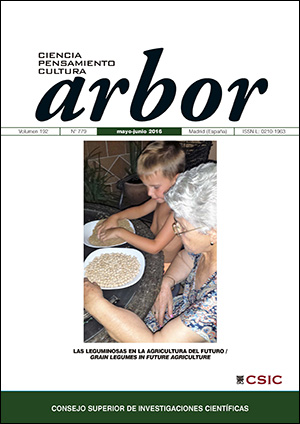Grain legumes in spanish and european agriculture
DOI:
https://doi.org/10.3989/arbor.2016.779n3001Keywords:
grain legumes, pulses, chickpea, faba bean, lentil, pea, bean, soyaAbstract
Grain legume cultivation is continuously decreasing in Spain in spite of the long tradition of their cultivation and consumption and their well-known environmental benefits by improving soil fertility. Grain legumes have been replaced in rotations by other crops that have adapted more quickly to technological progress and are more profitable for farmers in the short term. A similar change is taking place in Europe. This generates two major dependencies that can only be alleviated by increasing legume cultivation. On the one hand, Europe faces an increasing dependency on nitrogen fertilizers, using up to 10 million tons yearly, of which about 80% are imported. In addition to this, fertilizer production uses large amounts of energy, being highly dependent on natural gas, of which the EU imports 60% of its requirements. On the other hand, EU countries import 70% of their requirements as vegetable protein. In Spain, we import 4.7 million tons of grain legumes yearly, most of which is soybean (95% of the total). The decline in human consumption does not justify the reduction in cultivation, as we import 85% of the dried beans, 60% of the lentils and 75% of the chickpeas consumed in Spain. This dependency on imports, particularly on soybean, poses a serious threat to the economy as it makes the raw feed industry, and therefore most of the meat industry, vulnerable to fluctuations in the world soybean price.
Downloads
References
Arnoldi, A., Zanoni, C., Lammi, C. y Boschin, G. (2015). The role of grain legumes in the prevention of hypercholesterolemia and hypertension. Critical Reviews in Plant Sciences, 34, pp. 144- 168. http://dx.doi.org/10.1080/07352689.2014.897908
Delgado-Andrade, C., Olías, R., Jiménez-López, J. C. y Clemente, A. (2016). Aspectos de las legumbres nutricionales y beneficiosos para la salud humana. Arbor, 192 (779): a313. http://dx.doi.org/10.3989/arbor.2016.779n3003
Duc, G., Agrama, H., Bao, S., Berger, J., Bourion V., de Ron, A. M., Gowda, C. L. L., Mikic, A., Millot, D., Singh, K., Tullu, A., Vandenberg, A., Vaz Patto, M. C., Warkentin, T. y Zong, X. (2015). Breeding annual grain legumes for sustainable agriculture: new methods to approach more complex traits and target new cultivar ideotypes. Critical Reviews in Plant Sciences, 34, pp. 381-411. http://dx.doi.org/10.1080/07352689.2014.898469
Ramírez-Bahena, M. H., Peix, A., Velázques, E. y Berdmar, E. (2016). Historia de la investigación en la simbiosis leguminosa-bacteria: una perspectiva didáctica. Arbor, 192 (779): a319. http://dx.doi.org/10.3989/arbor.2016.779n3009
Rubiales, D. y Mikic, A. (2015). Introduction: legumes in sustainable agriculture. Critical Reviews in Plant Sciences, 34, pp. 2-3. http://dx.doi.org/10.1080/07352689.2014.897896
Rubiales, D., Fondevilla, S., Chen, W., Gentzbittel, L., Higgins, T. J. V., Castillejo, M. A., Singh, K. B. y Rispail, N. (2015). Achievements and challenges in legume breeding for pest and disease resistance. Critical Reviews in Plant Sciences, 34, pp. 195-236. http://dx.doi.org/10.1080/07352689.2014.898445
Rubio, L. A. y Molina, E. (2016). Las leguminosas en alimentación animal. Arbor, 192 (779): a315. http://dx.doi.org/10.3989/arbor.2016.779n3005
Vaz Patto, M. C., Amarowicz, R., Aryee, A. N. A., Boye, J. I., Chung, H. J., Martín-Cabrejas, M. A. y Domoney, C. (2015). Achievements and challenges in improving the nutritional quality of food legumes. Critical Reviews in Plant Sciences, 34, pp. 105-143. http://dx.doi.org/10.1080/07352689.2014.897907
Published
How to Cite
Issue
Section
License
Copyright (c) 2016 Consejo Superior de Investigaciones Científicas (CSIC)

This work is licensed under a Creative Commons Attribution 4.0 International License.
© CSIC. Manuscripts published in both the printed and online versions of this Journal are the property of Consejo Superior de Investigaciones Científicas, and quoting this source is a requirement for any partial or full reproduction.
All contents of this electronic edition, except where otherwise noted, are distributed under a “Creative Commons Attribution 4.0 International” (CC BY 4.0) License. You may read the basic information and the legal text of the license. The indication of the CC BY 4.0 License must be expressly stated in this way when necessary.
Self-archiving in repositories, personal webpages or similar, of any version other than the published by the Editor, is not allowed.














